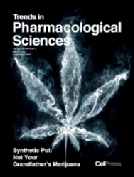
“Cannabinoid receptors, endocannabinoids and the enzymes responsible for their biosynthesis and degradation constitute the endocannabinoid system. In recent decades, the endocannabinoid system has attracted considerable interest as a potential therapeutic target in numerous pathological conditions. Its involvement in several physiological processes is well known, such as in energy balance, appetite stimulation, blood pressure, pain modulation, embryogenesis, nausea and vomiting control, memory, learning and immune response, among others, as well as in pathological conditions where it exerts a protective role in the development of certain disorders. As a result, it has been reported that changes in endocannabinoid levels may be related to neurological diseases such as Parkinson’s disease, Huntington’s disease, Alzheimer’s disease and multiple sclerosis, as well as anorexia and irritable bowel syndrome. Alterations in the endocannabinoid system have also been associated with cancer, affecting the growth, migration and invasion of some tumours. Cannabinoids have been tested in several cancer types, including brain, breast and prostate cancers. Cannabinoids have shown promise as analgesics for the treatment of both inflammatory and neuropathic pain. There is also evidence for a role of the endocannabinoid system in the control of emotional states, and cannabinoids could prove useful in decreasing and palliating post-traumatic stress disorder symptoms and anxiolytic disorders. The role of the endocannabinoid system in addictions has also been examined, and cannabinoids have been postulated as alternative and co-adjuvant treatments in some abuse syndromes, mainly in ethanol and opioid abuses. The expression of the endocannabinoid system in the eye suggests that it could be a potential therapeutic target for eye diseases. Considering the importance of the endocannabinoid system and the therapeutic potential of cannabinoids in this vast number of medical conditions, several clinical studies with cannabinoid-based medications are ongoing. In addition, some cannabinoid-based medications have already been approved in various countries, including nabilone and dronabinol capsules for the treatment of nausea and vomiting associated with chemotherapy, dronabinol capsules for anorexia, an oral solution of dronabinol for both vomiting associated with chemotherapy and anorexia, a Δ9-tetrahydrocannabinol/cannabidiol oromucosal spray for pain related to cancer and for spasticity and pain associated with multiple sclerosis, and an oral solution of cannabidiol for Dravet and Lennox-Gastaut syndromes. Here, we review the available efficacy, safety and tolerability data for cannabinoids in a range of medical conditions.”
https://www.ncbi.nlm.nih.gov/pubmed/30374797
https://link.springer.com/article/10.1007%2Fs40265-018-0996-1
 “Changes in lipid metabolism are intimately related to cancer. Several classes of bioactive lipids play roles in the regulation of signaling pathways involved in neoplastic transformation and tumor growth and progression.
“Changes in lipid metabolism are intimately related to cancer. Several classes of bioactive lipids play roles in the regulation of signaling pathways involved in neoplastic transformation and tumor growth and progression.







